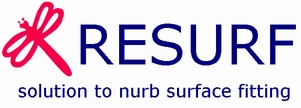

|
| Home | Products | Purchase | Change log & Road map | Gallery | Support | Download | Contact | 中文 |
Home > Documentation for RhinoResurf Table of Contents 1. Introduction
2. Command Reference
|
Tutorial 4 - Convert a mesh to multiple surfaces with quad face
In this tutorial we will convert a selected mesh to multiple surfaces. For this tutorial you also can refer to the video http://www.resurf3d.com/maindoc/footdemo.zip or http://www.resurf3d.com/maindoc/curve_network.rar and http://www.resurf3d.com/maindoc/trimsurf1.rar Firstly, let us review the workflow of how to convert a mesh to multiple surfaces with quad face: Generally, the workflow of this tool includes 4 steps: Step 1: create/import a curve network for the target mesh model; Step 2: click Check button to get initial surfaces. Step 3: click Fit button to get high quality surfaces. Step 4: check if there is undesired surface, if so, use Fix button to fix the surface; To convert a selected mesh model to multiple surfaces Step 1 : Start Rhino. Step 2: Select Import… from the File menu. The import file dialog box is displayed. Browse for the file saddlemesh.stl (typically located in C:\Program Files\Rhinoceros 4.0\Plug-ins\RhinoResurf\ Samples\) and click Open from the Open dialog box .
Step 5: click Osnap on the bottom of Rhino window (see the following picture). Select the checkbox End and Mid , make sure that when you snap the end point of a polyline, you will see a prompt ‘End' under the cursor, when you snap the interior point of a polyline, you will see a prompt ‘Mid' under the cursor. In order to get a good curve network connection, do not use ‘Mid' snap to select the interior point in our operation.
Step 6: Draw first line on the mesh. Click Create button in the Curve Network panel. Click left-mouse button to select the target mesh again. After you selected the target mesh, click right-mouse button. The mouse cursor will turn to be cross. When you see Start point of polyline on mesh in the Rhino command prompt, click left-mouse button to select a point on the mesh. Then you will see Next point of polyline on mesh in the Rhino command prompt, you select second point on the mesh, then third point…… when you would like to finish this line, click right-mouse button.
Step 7: Draw second line on the mesh. After you finished the first line on mesh, continue to click right-mouse button. Then select the target mesh again, you will start to draw second line on the mesh. Before you start to select the Start point of polyline on mesh , please note that the start point should snap one of the two end points of the first line . Therefore, you zoom out the first line, move the cursor on the end line point, when you see ‘End' under cursor, click left-mouse button to snap the end point, then select second point on mesh, third point on mesh …… when you would like to finish the line, click right-mouse button.
Step 8: Draw third line on the mesh. Continue to click right-mouse button. Then select the target mesh again, you will start to draw third line on the mesh. Before you start to select the Start point of polyline on mesh , please note that the start point should snap one of the end points of the existing lines (keep this regulation in the later lines, please always use ‘End' to snap end point, do not use ‘Mid' to snap interior point). You move the cursor on the end of the second line, when you see ‘End' under cursor, select the end point. Then select second point, third point…..Click right-mouse button to finish the third line.
Step 9: Draw fourth line on the mesh. Continue to click right-mouse button. Then select the target mesh again, you will start to draw fourth line on the mesh. Before you start to select the Start point of polyline on mesh , please note that the start point should snap one of the end points of the existing lines . You move the cursor on the end of the third line, when you see ‘End' under cursor, select the end point. Then select second point, third point…..When you would like to finish this line, and would like to create a quad shape, please move cursor to the end point of the first line, when you see ‘End' under cursor, snap the end point , and click right-mouse button. Finally, you get a quad shape, a NURB surface will created from this quad shape. Please use this regulation to create later quad faces.
Step 10: Continue to draw other lines on the mesh by keeping the end point snap regulation. When you finished drawing line, you will get a curve network like the following picture.
Step 11: Click Save button in the Curve Network panel. Save the curve network in a file named saddlecurve.nc for later use. Step 12: Click Check button in the Surface panel, the initial surface patches will be created quickly. These surfaces are the base surfaces for advanced fitting .
Step 13: Click Fit button in the Surface panel to get an advanced fitting. After this step, the surfaces will fit to the mesh nodes under the specified max tolerance (here default is 0.5) and reach G1 continuity for boundary transition. Sometime this step may take long time.
Step 14: Change the Max Tol to be smaller (such as 0.3), click Fit button again, you will get updated surface with smaller tolerance.
|
Copyright (C) 2007-2012 RESURF All Rights Reserved. Privacy Statement |